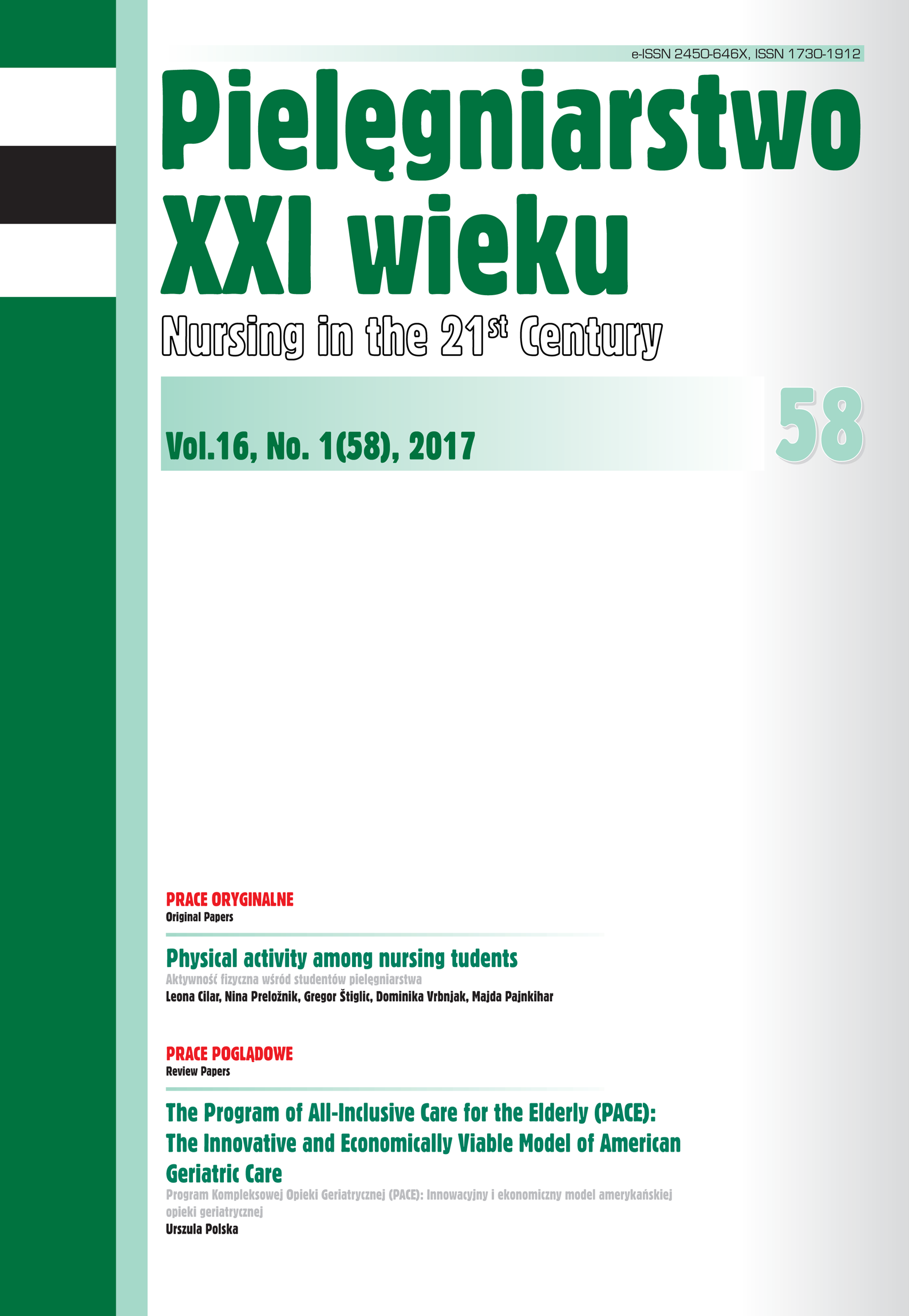The Program of All-inclusive Care for the Elderly (PACE ): The innovative and economically viable model of American Geriatric Care
DOI:
https://doi.org/10.1515/pielxxiw-2017-0008Keywords:
geriatric care, The Program of All-Inclusive Care for the Elderly (PACE)Abstract
THE PROGRAM OF ALL-INCLUSIVE CARE FOR THE ELDERLY (PACE ): THE INNOVATIVE AND ECONOMICALLY VIABLE MODEL OF AMERICAN GERIATRIC CARE
The aim of this paper is to present a modern model of non-institutional geriatric care which operates in the US, called the Program of All-Inclusive Care for the Elderly (PACE). The economic consequences of an aging population with multiple chronic diseases are creating new solutions in the delivery of medical care. The author of the following article, based on review of PACE literature and her own experience, will focus on the history of the program, its nature, the social and economic advantages, and its efficacy in practice. In addition, the difficulties and limitations of PACE are analyzed, taking into account solutions for increased availability and popularization of the program on an international scale.
Author currently works as an ANP at Mercy LIFE (Living Independently For Elders) of Alabama, a PACE organization, delivering primary care. She has identified a need for a model similar to PACE in the context of her own home country of Poland, where cultural and societal norms value caring for a loved one in his or her own household rather than institutional care.
The author concludes that the PACE model would be indispensable as a geriatric healthcare model for countries outside the US experiencing a rapid growth in elderly patients resulting from demographic shifts common in the 21st century. Fast response is needed in creation of a similar program to PACE to prevent future economical consequences affecting medical care for the elderly.
References
1. Carr E. Caring for An Aging Population. Stanford Social Innovation Review, Oct.21, 2016. Available at https://ssir.org/articles/entry/caring_for_an_aging_population. Access: 02.12.2016
2. Ortman JM, Velkoff VA, Hoga H. An Aging Nation: The Older Population in the United States U.S. Department of Commerce Economics and Statistics Administration. Current Population Reports. Issued May 2014, 25-1140.
3. Shear S. Expending the Program of All Inclusive Care for the Elderly in Alabama to Improve care and limit Cost for Frail Adults. (PACE) Addressed to Budget Committee of the Alabama Assembly. 2016.
4. Neuman T, Cubanski J. The Rising Cost of Living Longer: Analysis of Medicare Spending by Age for Beneficiaries in Traditional Medicare. Jan 14, 2015. Available at http://kff.org/medicare/report/the-rising-cost-of-living-longer-analysis-of-medicarespending-by-age-for-beneficiaries-in-traditional-medicare. Access: 02.12.2016
5. Center on Budget and Policy Priorities. Basics Introduction to Medicaid, Updated, August 16, 2016. Available at http://www.cbpp.org/research/health/policy-basicsintroduction-to-medicaid. Access: 02.12.2016
6. Casiano A. PACE: A Model of Care for Individuals with Multiple Chronic Conditions.” Annals of Long Term Care: Clinical Care and Aging. 2015;23(7):41-45.
7. National PACE Association. Is PACE for You? Available at http://www.npaonline.org/pace-you#History. Access: 02.12.2016
8. Hirth V, Baskins J, Dever-Bumba M. Program of All-Inclusive Care (PACE):Past, Present, and Future. J. Am Med Dir Assoc. 2009; 10(3):155-160. Available at http://www.dhcs.ca.gov/provgovpart/Documents/Waiver%20Renewal/PACE_Article_JAMDA_091.pdf.
9. Petigara T, Anderson G. Program of All-Inclusive Care for the Elderly. Health Policy Monitor, April 2009. Available at http://www.npaonline.org/sites/default/files/PDFs/Health%20Policy%20Monitor%20-%202009.pdf.
10. Center for Medicare and Medicaid Services. Quick Facts About Programs of Allinclusive Care for the Elderly (PACE) January 2008 Available at https://www.cms.gov/Medicare/Health-Plans/pace/downloads/externalfactsheet.pdf
11. National PACE Association. Understanding PACE Program All-Inclusive Care for the Elderly Available at http://www.npaonline.org/sites/default/files/PDFs/3%20 PACE%20Fact%20Sheet%20DRAFT%201.pdf
12. PACE Programs, a Budding Solution for Extended Care, Threatened by Proposed Budget. Alabama Media Group Marketing Staff March 17, 2016. Available at http://blog.al.com/sponsored/2016/03/pace_programs_a_budding_soluti.htm. Access: 02.12.2016
13. National PACE Association. Understanding PACE. A Profile of PACE. Available at http://www.npaonline.org/sites/default/files/PDFs/7%20Profile%20of%20PACE%20DRAFT%201.pdf.
14. Code of Federal Regulation. Available at http://pace.techriver.net/website/download.asp?id=2520&title=PACE_Regulations-Final_and_Interim_-_as_of_5/31/13. Access: 02.12.2016
15. CMS: Programs of All Inclusive Care for the Elderly (PACE) Regulation and Guidance Chapter 8 IDT, Assessment & Care Planning https://www.cms.gov/Regulations-and-Guidance/Guidance/Manuals/downloads/pace111c08.pdf.
16. Retooling for an Aging America: Building the Health Care Workforce. New Models of Care Chapter: 3, 2008. Available at https://www.nap.edu/read/12089/chapter/5#118. Access: 02.12.2016
17. National PACE Association. PACE in Your Community: Understanding PACE Operating Experience and the Critical Success Factors. March, 2013 Available at http://www.npaonline.org/sites/default/files/PDFs/PACE%20Critical20Success%20Factors%20White%20Paper.pdf.
18. Alabama Medicaid Agency. Admission and Evaluation Assessment Tool for PACE. Form:12-001 September, 2012 Available at http://www.smartbudgeting.alabama. gov/documents/5.0_Resources/5.4_Forms_Library/5.4.3_LTC_Services/5.4.3_PACE_Assessment_Form_12-001_9-14-12.pdf.
19. Pope G, Kautter O, Ingber M, Freeman S, et al. Evaluation of the CMS-HCC Risk adjustment model. Final Report RTI Project Number 0209853.006 Available at https://www.cms.gov/Medicare/HealthPlans/MedicareAdvtgSpecRateStats/Downloads/Evaluation_Risk_Adj_Model_2011.pdf.
20. Mecicare.gov What Part A Covers? Available at https://www.medicare.gov/whatmedicare-covers/part-a/what-part-a-covers.html. Access: 02.12.2016
21. Mecicare.gov What Part B covers? Available at https://www.medicare.gov/whatmedicare-covers/part-b/what-medicare-part-b-covers.html. Access: 02.12.2016
22. PACE and Medicare Risk Adjustment. Available at http://pace.techriver.net/website/article.asp?id=808. Access: 02.12.2016
23. PACE Programs Allow Elderly to Live at Home Longer and Save the State Money. Mercy LIFE Alabama, Media Group July 26, 2016 Available at http://blog.al.com/sponsored/2016/07/pace_programs_allow_elderly_to.html. Access: 02.12.2016
24. Evaluation of the Program of All- Inclusive Care for the Elderly (PACE) Demonstration: The Impact of PACE on Participant Outcomes Final Report for HCFA Contract #500-96-0003/TO4. July,1998. Available at https://www.npaonline.org/sites/default/files/PDFs/Impact%20of%20PACE%20on%20Participant%20Outcomes.pdf.
25. Temkin-Greener H, Mukamel D. Predicting Place of Death in the Program of All-Inclusive Care for the Elderly (PACE): Participant versus Program Characteristics. Journal of the American Geriatrics Society 2002; 50: 125-135. doi:10.1046/j.1532-5415.2002.50018.x.
26. Lynch M, Hernendez M, Estes C. PACE Has it Change the Chronic Care Paradigm? Social Work in Public Health. 2008; 23 (4): 3-23.
27. Counsell SR, Callahan CM, Buttar AB,Frank Kl, Geriatric Resources for Assessment and Care of Elders (GRACE) Model: A New Model for Primary Care for Low Income Seniors J AM Geriatric Soc. 2006; 54(7):1136-1141.
28. Kane RL, Homyac P, Bershadsky B. Consumer Reactions to the Wisconsin Partnership Program and Its Parent, the Program for All-Inclusive Care of the Elderly (PACE) The Gerontologist. 2002; 42 (3): 314-320.
Published
Issue
Section
License
Copyright (c) 2017 Author

This work is licensed under a Creative Commons Attribution-NonCommercial-NoDerivatives 3.0 Unported License.




